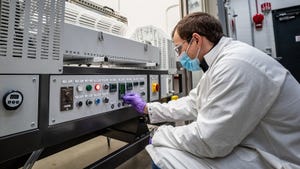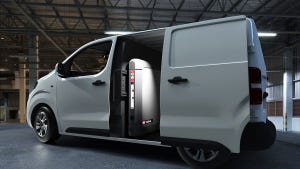Ultracapacitors Replace Batteries in Wind Turbine Blade Pitch Systems
In the areas of safety, efficiency, and maintenance costs ultracapacitors are gaining traction.
December 16, 2021

In the US, wind power accounted for about 8.4 percent of electrical energy generation in 2020. It also accounted for 42 percent of new US generating capacity. As demand has grown for renewable energy so has wind turbine technology progressed to the point where a modern turbine can have blades longer than 70 meters and produce as much as 10 megawatts of electrical power when the wind is blowing.
To produce these high-power outputs, the blades must be fine-tuned by constantly monitoring and adjusting their pitch. Pitch refers to the angle of the turbine blades, maximizing power output from the wind turbine by operating it at optimum speed while also protecting it from high-speed winds. Each blade of the turbine requires a motor to adjust the blade along with the equipment and systems to ensure proper control and protection. In heavy winds the blades must be turned to a neutral angle, depowering the turbine and protecting it from running at too great a speed. To avoid a catastrophe, the pitch control system must work and have sufficient power to turn the blades even if the main power for the blade pitch control has failed.
Historically, the wind industry has relied upon either hydraulic or lead-acid battery systems to power the pitch control system. Hydraulic systems are complex and have been proven to require significant maintenance. Electrically operated systems running on lead-acid batteries are also maintenance intensive. One solution that is gaining acceptance is ultracapacitors.
Ultracapacitors are electronic devices that are capable of storing and discharging energy very quickly and efficiently. Ultracapacitors can produce quick bursts of electrical energy but are not capable of producing the long discharge rates of an ordinary battery. During the past decade, the cost of ultracapacitors has continued to drop to the point where their initial investment is similar to that of a battery. However, the minimal maintenance over a 15+ year lifetime gives the ultracapacitor advantages in certain applications that require short-duration high power outputs.
One such application is turbine pitch control where, from the standpoint of safety, efficiency, and maintenance costs ultracapacitors are gaining traction.
Richardson Electronics is one company that is developing an ultracapacitor module technology that can replace wind turbine batteries used for pitch control. The company has created an ultracapacitor-based plug-and-play replacement for batteries in wind turbine generator pitch systems. The ULTRA3000 PEM is a direct one-for-one replacement for batteries and chargers that can be installed with no modifications to the battery box. The company has been issued a patent on its ultracapacitor solution.
"We are pleased the U.S. Patent Office continues to recognize the innovations found in our ULTRA3000 PEM. The Richardson engineering team worked hard to create a true plug-and-play product which is environmentally friendly and easily installed," said Richardson's Greg Peloquin, Executive Vice-President, Power & Microwave Technologies Group in a company news release. "We are proud to provide a cost-effective, improved solution for replacing batteries in wind turbine pitch systems."
Kevin Clemens is a Senior Editor with Battery Technology.
About the Author(s)
You May Also Like





